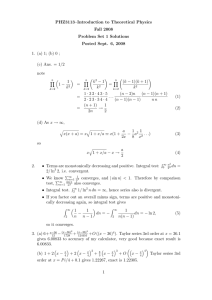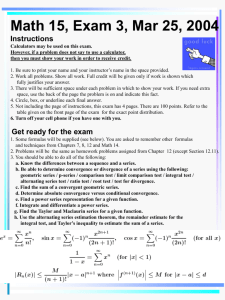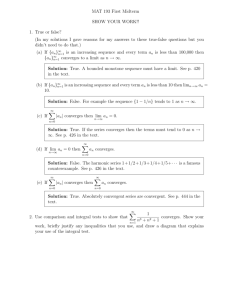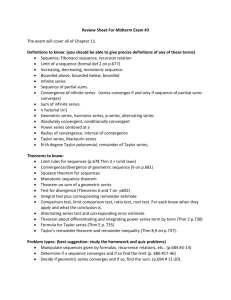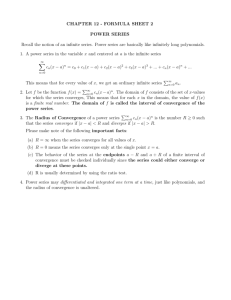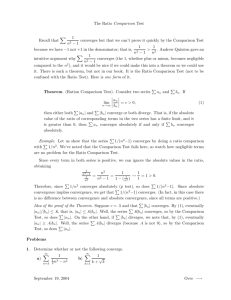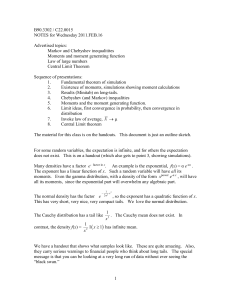Introduction/Series 1 Why this course exists
advertisement
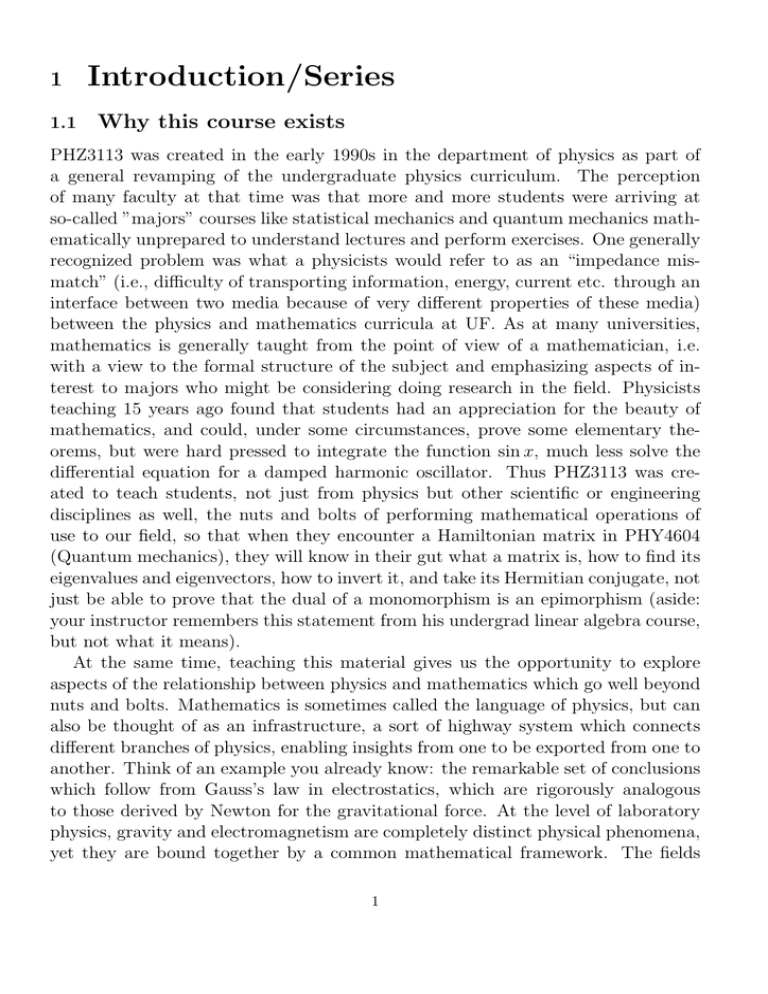
1 1.1 Introduction/Series Why this course exists PHZ3113 was created in the early 1990s in the department of physics as part of a general revamping of the undergraduate physics curriculum. The perception of many faculty at that time was that more and more students were arriving at so-called ”majors” courses like statistical mechanics and quantum mechanics mathematically unprepared to understand lectures and perform exercises. One generally recognized problem was what a physicists would refer to as an “impedance mismatch” (i.e., difficulty of transporting information, energy, current etc. through an interface between two media because of very different properties of these media) between the physics and mathematics curricula at UF. As at many universities, mathematics is generally taught from the point of view of a mathematician, i.e. with a view to the formal structure of the subject and emphasizing aspects of interest to majors who might be considering doing research in the field. Physicists teaching 15 years ago found that students had an appreciation for the beauty of mathematics, and could, under some circumstances, prove some elementary theorems, but were hard pressed to integrate the function sin x, much less solve the differential equation for a damped harmonic oscillator. Thus PHZ3113 was created to teach students, not just from physics but other scientific or engineering disciplines as well, the nuts and bolts of performing mathematical operations of use to our field, so that when they encounter a Hamiltonian matrix in PHY4604 (Quantum mechanics), they will know in their gut what a matrix is, how to find its eigenvalues and eigenvectors, how to invert it, and take its Hermitian conjugate, not just be able to prove that the dual of a monomorphism is an epimorphism (aside: your instructor remembers this statement from his undergrad linear algebra course, but not what it means). At the same time, teaching this material gives us the opportunity to explore aspects of the relationship between physics and mathematics which go well beyond nuts and bolts. Mathematics is sometimes called the language of physics, but can also be thought of as an infrastructure, a sort of highway system which connects different branches of physics, enabling insights from one to be exported from one to another. Think of an example you already know: the remarkable set of conclusions which follow from Gauss’s law in electrostatics, which are rigorously analogous to those derived by Newton for the gravitational force. At the level of laboratory physics, gravity and electromagnetism are completely distinct physical phenomena, yet they are bound together by a common mathematical framework. The fields 1 associated with a mass and a charge both fall off with the inverse square of the distance: Gm 1 q Egrav = 2 ECoul = , (1) r 4π0 r2 where q is the charge, m is the mass, and 1/(4π0 and G are the universal constants of electrostatics and gravity, respectively. But for any vector field E which falls off like from a point source as E = a/r2 (a is a constant) we have the mathematical result Z E · dA = 4πa (2) S for the flux of E through any surface S (recall that’s any closed surface S, not just a sphere). Thus we have shown that the gravitational field inside a uniform spherical shell of mass is exactly zero, by noting that a Gaussian sphere concentric with the center and with radius such that the surface is at the field point contains zero mass, and that therefore by symmetry (another mathematical idea), the field must be zero everywhere. Make sure you understand the “by symmetry” argument; we will use it often. Basically, it appeals to logic. On the Gaussian sphere (dashed line in figure), the field must point radially because there is no reason for it to point in any other direction. Therefore the integrand of the surface integral is a constant, so E must be zero if the total integral is to be zero. This is true everywhere inside cha r ge ass E=? ,m X Figure 1: Sphere of charge or mass: what is the field at the point X? the sphere since the choice of the Gaussian sphere was arbitrary. This little result seems of little practical interest, but is in fact directly related to the more powerful principle of superposition in the theory of gravitation. Note that nothing in our argument really depended on it being a shell of mass, however. It could have been a shell of charge, and the field E the electric field. 2 Therefore, without doing any further work, we see that because the mathematics are the same for the electric field, the result that ECoul should be zero inside a uniform shell of charge follows immediately. Imagine what an enormous help it was to the “natural philosophers” constructing electromagnetic theory to build on the mathematics already invented by Newton (and Leibniz)! In fact, Newton derived the result above and many others required for his theory of gravitation without the benefit of Gauss’s law, (logical, you say, since Gauss was born 50 years after Newton died). Most of electrostatics was also developed without it. The history is interesting but irrelevant to the point I wish to make, that there are important physical parallels between the theories of gravitation and electrostatics together due to the 1/r2 forces, and that it is the structure of the calculus of vector fields which allows us to see this. (Caveat and question for further thought (HW 1): in E& M you proved using a variant of this approach that the electric field inside a hollow conductor is zero. What’s the gravitational analog of this statement?) Series 1.2 Reading: Boas, Ch. 1 1.2.1 Taylor Series You all know that in most cases functions can be represented by their Taylor expansions, 1 1 f (x) = f (a) + f 0 (a)(x − a) + f 00 (a)(x − a)2 + f (3) (a)(x − a)3 + . . . , 2 6 (3) infinite power series with coefficients determined by the derivatives of the functions. We now investigate when this is possible in some more (but not terribly rigorous or complete) detail. PNQ: is itn possible to determine the function described by the polynomial P (x) = n=0 an x (a function of x ∈ R) completely for all x if you know all its derivatives at a single point x? Without loss of generality, let’s call the point we want to focus on x = 0. The coefficients of the Taylor series are a0 = P (0) ; a1 = P (1) (0) ; a2 = P (2) (0)/2 ; ... (4) If N is finite, the polynomial P (x) is indeed defined completely at all x merely by knowing all of its derivatives at 0; nothing can go wrong. 3 1.2.2 Convergence On the other hand, the properties of infinite series can be quite different from those of finite ones. Consider Taylor series of function Q(x) around x = 0, Q(x) = ∞ X xn n=0 n! Q(n) (0) (5) For a given x, the series of coefficients might not converge to a finite value, even if the individual terms are decreasing. Standard example is the “harmonic” series P 1 k k , which can be shown to diverge. The figure plots the result of adding up all the terms in the series up to a particular k, as a function of that upper value of k. You can pretty much see that the partial sums function looks like a log function, which will indeed diverge as its argument gets large. On the other hand, if you change the sign of every other term, the result converges, as seen in the last panel of the figure. (There is a very interesting discussion in Boas about the fact that this convergence is delicate, or “conditional”–if you rearrange the order of the terms you may get a different answer!) Figure 2: Partial sums of three harmonic-like series. pk are prime numbers. On the other hand, we have plenty of examples of simple infinite series which converge. Take for examine the series which results when your friends have bought a couple (exactly two) pizzas for a party, but invited too many people, to wit an infinite number. Each, being semi-polite, leaves half the remaining pizza for the rest. Then in units of pizzas, the sum is ∞ X 1 1 2−n . S = 1 + + + . . . ... = 2 4 n=0 4 (6) Note that if the fundamental law of conservation of pizza holds, the sum S had better 2. Since the terms are all positive, if we stop at any finite N , SN = PN be −n < 2. n=0 2 Let’s generalize this a bit. Suppose we have the “geometric series” N X 1 − rN +1 1 rN +1 r = SN = = − . 1 − r 1 − r 1 − r n=0 n (7) The result is given as problem 2 (with hint) in Boas chapter 1. Now consider two cases: 1. r < 1: The second (“remainder”) term vanishes as N → ∞, so SN →∞ = 1/(1 − r). Special case: r = 1/2 and we have our pizza result S = 2. Note for this case, the series converges absolutely, i.e. we can sum the terms in any order. 2. r > 1: You can tell from examining the terms that they are all positive and monotonically increasing. Therefore it is clear that the series diverges in this case as N → ∞. For some functions, convergence or divergence of the Taylor series may depend on the value of x, since each x produces a different series in general. If the series is known to converge at x, it usually does so over a range of x nearby. For example, take the Taylor expansion of x2 x3 ln(1 + x) = x − + + ... 2 3 (8) You can apply a number of tests (see Boas) to show that this series converges if |x| < 1, called an “interval of convergence”. The size of this region is called the “radius of convergence”. 1.2.3 Tests for convergence 1. Comparison test. If you know a series converges, then another series whose terms are bounded by those of the convergent one also converges. converges, so does the series. If 2. Integral test. If the “corresponding” Pintegral ∞ 2 it diverges, so does the series. Ex: n=1 1/n . Examine the integral ∞ Z ∞ −1 −2 n dn = = 1, (9) n 1 1 5 so yes the sum will also converge. Note the lower limit does not matter for the test, since divergence problems arise from the upper limit, except if the integral or sum diverges at the lower limit (had we taken the lower limit to be zero the sum and integral would have both been divergent). 3. Ratio test. Define ratio of subsequent terms an+1 ρn ≡ an lim ρ ρ = n→∞ n (10) (11) If ρ < 1 series converges. Application to Taylor series. Consider a function with expansion f (x) = ∞ X bn x n . (12) n=0 The ratio test says that f (x) converges, i.e. the sum is a valid representation of the function, if n+1 b x lim n+1 ρ ≡ n→∞ (13) bn x n < 1 bn lim . (14) ⇒ |x| < n→∞ bn+1 This gives interval of convergence of Taylor series. P (−x)n 2 3 Ex: f (x) = ∞ n=0 2n = 1 − x/2 + x /4 − x /8 . . . . So power series converges for |x| < 2. 1.2.4 Remarks 1. If two functions the same Taylor they are the same function. P∞ have P∞ expansion, n n If f (x) = n=0 an x and g(x) = n=0 bn x , then an =bn and f = g. This is not always obvious for simple series, i.e. certainly 1+5 = 2+4 does not imply term by term equality. Intuitive point is that the relation has to be valid for any x, so this constrains coefficients. We’ll prove this later using complex variables. 2. Power series can be differentiated or integrated term by term, & resulting series converges to derivative/integral of the function, with same radius of convergence. 6 Ex: x2 x3 ln(1 + x) = x − + + ... 2 3 1 = 1 − x + x2 − . . . 1+x (15) (16) 3. Approximations for functions: stopping at finite order. Sometimes we are lazy and want to keep only a finite number of terms in an expansion, & ask what kind of an error we are making. Ex: x3 + O(x5 ) sin x = x − 3! π π 1 π 3 sin ' − = 0.499, 6 6 6 6 (17) (18) although the exact solution is 0.5. The remainder of the series makes only an extremely small change, at least near π/6. Note this particular series converges lim a /a fast enough, i.e. n→∞ → ∞, such that the radius of convergence is n n+1 infinite! 4. Nested expansions. Sometimes it’s easier to expand internal parts of a composite function in power series, rather than take derivatives formally as in Eq. 3. Ex: x exp 1−x x 1 = 1+ + 1 − x 2! x 1−x 2 = 1 + x(1 + x + x2 . . . ) + 3 13 = 1 + x + x2 + x3 . . . . 2 6 7 1 + 3! x 1−x 3 ... (19) 1 2 x (1 + x + x2 . . . )2 + . . . (20) 2! (21)
